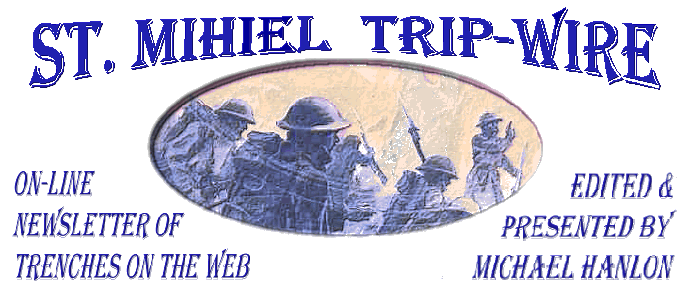
TRENCH REPORT: There is a WWI Mega-Event scheduled for September 7-9 in Newport, Rhode Island. The WFA-USA is holding their National Seminar at the Naval War College. I've enjoyed watching this program get built from scratch by the organization's president, T.J. Johnson. The theme is "What Were We Fighting Each Other For?", and the presentations cover all combatants, all theaters and all modes of combat. A number of contributors to our websites and publications, e.g. Len Shurtleff, Bob Denison and Steve Suddaby, are making presentations. The program is especially strong on addressing the war aims of the participants, which as you may be aware, weren't necessarily the same in 1918 as they were in 1914. (Program Info) . . . Correction: Last month our initial posting of the Trip-Wire gave an incorrect date for next year's dedication date for the Doughboy Statue at Cantigny, France. It is to be unveiled Wednesday, May 28, 2008. Apologies to all, especially my friend Fred Castier, who is coordinating this event for the First Division Foundation and Museum. MH
This Month's Internet Focus:
Battlecruisers and
the Great War |
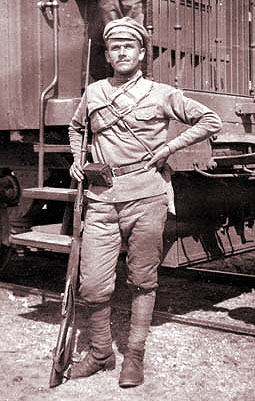
Czech Legionnaire in Siberia, 1918
New at Our Own & Our Friends' Great War Websites
Click on Title or Icon to Access
|
At Great War Society Sites
The Great War Society Announces
Seminar 2008
"War at Sea & in the Air",
April 11-13, South San Francisco
(Click for Details) |
At the WFA-USA
|

A singer once, I now am fain to weep
Within my soul I feel strange music swell,
Vast chants of tragedy too deep--too deep
For my poor lips to tell.Sgt. Leslie Coulson, Roy. Fusiliers
KIA, October 7, 1916
From the Somme
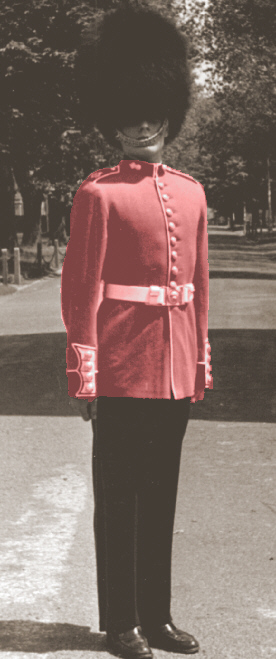
Trip-Wire & Website Contributor Sidney Clark
When He Was a Brand-New Grenadier Guard
(Read Sidney's Latest Article)
|
| |
Road from Arras to Bapaume
by C.R.W. Nevinson, 1918

Those Romans Believed in Straight Roads, Didn't They?
|
GREAT WAR 2007 EVENT CALENDAR
|
90th Anniversary
Palestine Campaign
International Conference
September 3-6, 2007
Tel-Hai Academic College in Upper Galilee, Israel (email for details)
|
What We Fought
Each Other For
WFA-USA
18th National Seminar
September 7-9, 2007
Naval War College Newport, RI (Full Program)
|
T. E. Lawrence: A Symposium
The Huntington Library,
October 5-6, 2007
San Marino, CA (email for info.)
|
International Society for
First World War Studies
International Conference
General Sessions Closed To Public
Announcement To Follow On Open Event(s)
October 18-20, 2007
Georgetown University, Wash., D.C. (link)
|
Western Front Association
U.S. Branch Chapter Meetings
Check for Your Region
Regularly Updated (details)
|
Great War Society Monthly Chapter Meetings
Berkeley, San Francisco and Palo Alto, CA
Regularly Updated (details)
|
Send additions/corrections:
Email Response
|
 Memorable Event
Memorable Event
|

Lt. General Oscar von Hutier
Breakthrough Techniques Tested
at Battle of Riga
September 1, 1917
Click on Image for More Information
|
|
WWI Film Class: The University of Missouri-Kansas City and The National World War I Museum are co-sponsoring a 12-session course examining how World War I has been portrayed in popular film and culture from the early 20th century to the present. The public is invited to explore this topic for free as more than 100 seats have been set aside each week in the J. C. Nichols Auditorium at The National World War I Museum at the Liberty Memorial. The course, taught by Professors Tom Poe and Dennis Merrill on Thursday nights beginning August 30, will draw on the disciplines of Communication Studies and History. Classes will begin at 6 p.m. No registration is required for the free program. Seats are available each week on a first-come, first-served basis. For more information on this program, contact J. Barkley at 816-784-1926.
More WWI Movies Coming: Singer-turned-actor Özcan Deniz is currently preparing for the lead role in an upcoming film that will depict the Battle of Sarikamis, where tens of thousands of Turkish soldiers froze to death during World War I. Deniz says the film is going to be the most ambitious movie made in the history of Turkish cinema.
Film researcher Valerie Yaros has discovered two excellent sites about the Canadian film, Passchendaele, now in production. (background) & (blog) |
The Historical Society of Washington is commemorating the 75th anniversary of the Bonus Army's march with the opening of an exhibition, "Wages of War: Bonus Army to Baghdad." The exhibition runs through Veterans Day. (link)

Seven Victoria Crosses were won by Australians at Lone Pine, the set of Turkish trenches south of Johnston's Jolly, taken and held by the Australians during the August 1915 fighting at Gallipoli. The memorial at Lone Pine is a focal point for the annual ANZAC Day Commemoration.
|
An Air Observer Over North Paris
by Henry Cheffer
|
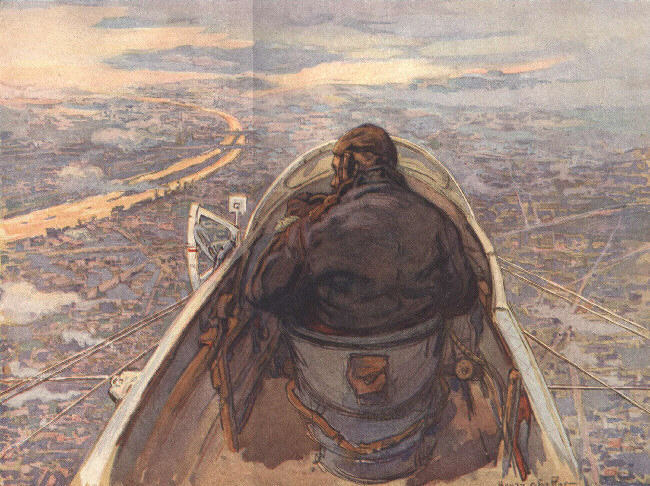
|
|
Page Two
|
Eyewitness: A Yank Doctor Assigned to Tommy's Trenches.
|

Doctor At Work in a British Trench
[Not Western Front] |
"Think of the stick man, check off his body parts, remember what’s most
important. Keep the airway clear, stop the bleeding, clean out the wounds, be
methodical. Stabilize and move on, stabilize and move on. Be in charge. Once the
patients are stabilized, get that tetanus antitoxin in them, then double check
everything. Splint still in place? Has the tourniquet been on too long? Has the
artery started bleeding again? Is the wound really cleaned out?"
Col. Burroughes interrupted my mental exercise and took me to the front
line. As the communication trench neared the actual front most line, it struck me
that this was the business end of the Western Front. All the supplies, hospitals,
ships, reserve areas, kitchens, communication wires—all that, was to serve and
maintain this, the front line: the point of contact with the Boche, the Hun, Jerry.
Thinking back on all I’d seen before, it struck me there had to be 20, or 50, or
maybe 100 people behind us for every one fighting soldier right up in the front
line. Inefficient business, war is. And was it smelly; the stench of the Front was
pervasive and horrible.
In the last stretch of communication trench (that trench connecting the
reserve line of trenches with the front line), There was a dugout on the right with
the worst smell of excrement coming out of it. A man emerged holding a large
bucket of human feces just as we passed by.
“‘Scuse me.”
“Of course,” Wasn’t about to get in his way.
“Shit wallahs, Gallagher,” Col Burroughes told me. (He never called me
anything but Gallagher, never Ben, never doctor, never lieutenant. In the
hierarchy of the British Army, I was below Burroughes, so I was addressed
appropriately. There was nothing personal in it, for Burroughes was all kindness
to me, but the forms of address in a hierarchy are etched in stone.)
“Shit wallahs. The ‘wallah’ part of it is an Indian term, I think, for
“carrier” or something. The ‘shit’ part I think you know.” Burroughes was
pointing to the man carrying the bucket of shit. By now, this man had walked
some distance away, down the communication trench. Passersby were giving him
a wide berth, as wide as you can give in a trench.
“What do they do, exactly, Col. Burroughes, these shit wallahs?” The
answer seemed pretty obvious, but I didn’t want to look uninterested. This was
my first day in a trench and I didn’t want to look like a know-it-all.
“Keep the trench clean. Clean as they can, anyway. Men can’t just be
crapping anywhere. They use a bucket in this dugout here,” he pointed to the
smelliest dugout on earth, above it was a sign, “Rose Hips and Jasmine Lane.”
The British sure came up with the funniest names for places. Rose hips and
jasmine did not come to mind when one smelled that dugout! “The shit
wallahs—we have two per battalion—carry it away and dump it.”
Looking around the crowded, narrow trench, I couldn’t imagine where,
exactly, “away” was. Just then, a second fellow emerged holding another bucket
of excrement. This was proving to be my lucky day.
“Colonel, Leftenant,” he gave us a quick salute with his . . . unoccupied . . . hand. “That’s a good question you’ve got there, Leftenant, where to put the, uh, digestive byproducts, you might call ‘em.” The shit wallah was rolling back on his heels, enjoying his moment in the sun—a real orator, addressing one of the great questions of our time. And all the time holding that
bucket. Jeez, Louise.
“Well, it all depends on whether Jerry’s got a stunt up his sleeve, or
whether we’re putting on a show.” His free hand gestured to the left, and the
right, indicating the great dichotomy of thought on this issue. “If we’re expecting
a visit from Jerry, we throw it out in front of our lines, so he gets a nasty
surprise. And if we’re the ones putting on the show, we throw it behind our lines,
to encourage our lads to go forward. Har, har, har!” The man was a genius.
Someday surely he would be prime minister.
Burroughes had to smile at the shit wallah’s explanation.
“Very well, soldier; carry on.”
The shit wallah saluted and headed back down the communication trench,
still laughing.
We bid “Rose Hips and Jasmine Lane” a fond farewell and got into the
front line. My heart caught a little in my throat. This was it. The front line. THE
FRONT LINE.
For years I’d followed the progress of the war in the newspapers. I’d read
Guy Espy’s (sic) book Over the Top. They’d even shown us newsreels of some trench
scenes. But to be in the front line, to actually BE in the front line . . . the reality
proved somewhat anti-climactic. The atmosphere was work-a-day, with little
drama about it.
Dr. Ben Gallagher in the outstanding memoir:
The Cellars of Marcelcave: A Yank Doctor in the BEF.
(order here)
|
|
Germans Retake Fort Douaumont --
in 1940
By Christina Holstein
After the Armistice, Fort Douaumont was left in its wartime state and partially opened for visits. During the 1930s . . . steps were taken to strengthen certain defensive elements, including the deep tunnels and some of the armoured turrets. Despite that, in June 1940, Fort Douaumont fell again to the Germans after brief combat. To many German soldiers - including, no doubt, to Eugen Radtke who returned in 1941 to attend ceremonies commemorating the twenty-fifth anniversary of the battle - it must have seemed as if the battle for Fort Douaumont had finally been won.

German Flags Over Douaumont
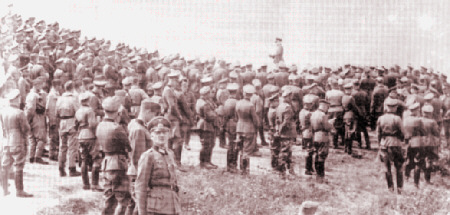
Generalmajor Haupt Explaining in August 1940 How He Stormed the Fort in 1916
This except and the photos are by permission from Christina's 2002 book Fort Douaumont, from Pen and Sword's "Battlegrounds Europe" series and can be ordered at
www.amazon.com
|


North African Cavalry Guarding German Prisoners of War, 1914
From "Flambeau", Sunday Supplement to Le Monde
Click Here to Visit War in a Different Light
|

|
1917 on The Western Front
By Tony Noyes
As Summer Ends
To Stop or Continue In Flanders/
Petain Rallies the French Army
|
Haig couldn't do much else -- in general terms, his men were in exposed positions, easily raked by hostile gunfire on the heights above and out of their original miserable trenches which were at least capable of offering some shelter from the weather and were also in reach of their earlier supply lines.
At the end of August and into September the German's Menin Road defences were as strong as ever and stopped all possible major movements for the British out of the Salient, so they had to be taken & destroyed. The defences hinged upon two small woods, Glencorse and Inverness Copse, homely names for absolutely barbaric fighting during which both slaughterhouses changed hands many times. Shellfire had so destroyed the woods that they were absolutely unrecognizable as anything but abattoirs and stinking rubbish heaps. (These are now quiet woods filled with "holiday homes"; I wonder if those who use them know how many men of all the armies lie under their chalets).
In early September the weather improved. The mud began to dry out. Shellfire now produced dust clouds instead of gouts of mud.
At 0540 on 20 September and following five days of effective artillery bombardment, Plumer launched his well-planned attack against Gheluvelt up the Menin Road. A rolling barrage was used to great effect, and this had the advantage of making the defenders unsure of how the assault was progressing. Consequently, the British infantry was more effective at destroying German infantry and their pillboxes than during previous attacks. Glencorse and Inverness finally changed hands, taken with professional skill by 1st ANZAC Corps who then reached halfway into the next wood, Polygon. Other advances were made, and on the evening of that day heavy rain fell, and the battlefield reverted to mud and swamp. German counter-attacks were repulsed, and about one mile of progress had been made. The village of Zonnebeke was taken as a reeking rubbish heap. Today it is a prosperous village showing on the surface no signs of its terrible past.
The Germans counter-attacked often and viciously, and the slowly advancing new front line hesitated and then stopped.
The area today contains a small surviving number of the thousands of pillboxes although they are often in farmer's fields (mind the mud!).
The end of the month had brought progress for the British and Empire troops, but the weather was breaking and the mud fields were spreading. It was becoming harder to move the guns forward and for the men to move their positions either forward or out of the line.
|
Haig now had a second major decision to make just as one month previously -- to continue or to stop.
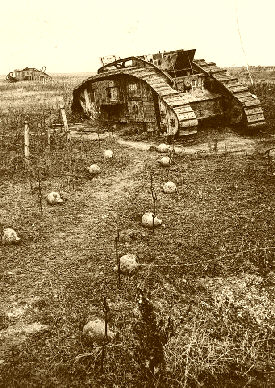
Disabled British Tanks
Petain now believed that he could ask the troops to make an assault on the existing German front lines to the north of Verdun, since he believed that they had recovered their élan sufficient to be asked to undertake their first major engagements since the troubles of summer 1917.
He asked, and they responded magnificently. In mid August he instructed a massive assault on both sides of the River Meuse at Verdun which by its efficiency and utter violence wrought tremendous infantry losses on the German defenders and by the end of August, moved the front lines about two miles away from Verdun. Here they stayed until the arrival of the Americans and their assault on September 26, 1918.
On the Chemin des Dames, to the northeast of Reims, a second violent French assault on October 23 took Fort Malmaison and cleared the defenders off the entire ridge. The Germans retreated north over the Ailette River to the next ridge and dug in. It was from here that their massive May 1918 assault was launched.
That was in the future, and the French army was slowly recovering, but what would the British do in Belgium?
|
|
|
Subscribe to Our New On-Line Magazine
|
|

|
|
|
Page Three
|
 |
THE RAINDROPS ON YOUR OLD TIN HAT
By Second Lt. Hunter J. Wickersham,
353rd Infantry, 89th Division, AEF
|
The Mist hangs low and quiet on a ragged line of hills,
There's a whispering of wind across the flat,
You'd be feeling kind of lonesome if it wasn't for one thing
The patter of the raindrops on your old tin hat.
An' you just can't help a-figuring--sitting there alone--
About this war and hero stuff and that,
And you wonder if they haven't sort of got things twisted up,
While the rain keeps up its patter on your old tin hat.
When you step off with the outfit to do your little bit,
You're simply doing what you're s'posed to do--
And you don't take time to figure what you gain or lose--
It's the spirit of the game that brings you through.
But back at home she's waiting, writing cheerful little notes,
And every night she offers up a prayer,
And just keeps on a-hoping that her soldier boy is safe--
The Mother of the boy who's over there.
And, fellows, she's the hero of this great, big ugly war,
And her prayer is on the wind across the flat,
And don't you reckon it's her tears, and not the rain,
That's keeping up the patter on your old tin hat?
|
|
|
One of the most famous poems composed by a World War I Doughboy, "Raindrops", was written by Lt. Wickersham the night before the St. Mihiel Offensive began. The next day, after being severely wounded by artillery fire, he continued leading his platoon despite a great loss of blood. He eventually died on the battlefield, receiving the Medal of Honor for his leadership, posthumously. His poem first appeared in Captain Billy's Whiz Bang, launching pad of Fawcett Publications and the inspiration for a host of humor magazines. (Learn more about Capt. Billy.)
|
|
A Forgotten Outstanding General
|

BG Dwight Edward Aultman |
One of the lesser known but most important facts about the Great War is that on November 1, 1918 the American Way of War was born. That is, the methodology and the thinking that seek to apply firepower, maneuver and technology -- in lieu of taking mass casualties -- to gain victory was first applied. This was the approach that guided U.S. military planners through the Second World War and Cold War, right up to the liberation of Baghdad in 2003. By November 1918, Pershing's troops had passed through a considerable learning curve. A new general, the thoughtful Hunter Liggett, who had been the AEF's best corps commander, assummed leadership of the First Army. He inherited a future Army Chief of Staff, George Marshall, as his Operations Officer, and two future Chiefs of Staff, Charles Summerall and John Hines were appointed Corps Commanders on the day he took his new position. This veteran team analyzed the AEF experience to date and decided that the large American Divisions were under-gunned. To break through in the Meuse-Argonne sector, they begged and borrowed every artillery piece they could from the French and British, brought in U.S. Coastal Artillery units to man the bigger guns, and stripped newly arrived Americans divisions of their crews and pieces. When the hammer blow was struck on the morning of November 1st, the last defensive line of the German Army was utterly shattered. The three best divisions of the AEF, the 1st, 2nd and 42nd, engaged in a dash to Sedan, the ultimate objective of the entire campaign.
The key formation for this breakthrough was Summerall's V Corps in the central Argonne, which brings us to the subject of this article. Charles Summerall was an artilleryman, who knew all the gunners in the army, and he picked the best man he knew of to be his Chief of Artillery for the battle. The man he chose was Brigadier General Dwight Edward Aultman [1872-1929], a West Pointer from Pennsylvania. He was a veteran of the Battle of San Juan Hill, the organizer of the new Cuban army's field artillery, and in 1915 a U. S. observer on the German Western Front. With the AEF he held progressively more important positions before his appointment with Summerall. His DSM citation reads: "As Chief of Artillery of the 5th Corps in the operations against the enemy in November, 1918, by his exceptional skill as an artillerist he was largely responsible for the rupture of the enemy's position and the breaking of his resistance."
General Aultman held a number of responsible positions after the war and did much to prepare U.S. artillery forces for their outstanding performance in WWII. He died of a long illness at age 57 when he was commanding the Field Artillery School at Fort Sill. His valuable service was later acknowledged with the launching of the transport the USS General D.E. Aultman, which saw war service in 1945, and today sits in the Reserve Fleet at Suisun Bay, California.Image and Details Contributed by MG Thomas Jones
|
|
World War I Headlines
in the
21st Century
|
|
 |
Hell Below
and the Career of
Cmdr. Edward Ellsberg, USN
By Andrew Melomet
|

Edward Ellsberg |
With the declaration of war in 1917, the U.S. Navy wanted to get its submarines involved in combat operations. However, the U.S. Navy submarines of the World War One era were relatively small vessels ranging in displacement from 287 to 510 tons. The fastest boats had a top surface speed of barely 14 knots on diesel power. By comparison, a World War Two Liberty ship did about 11 knots. The U.S. Navy separated the boats into two groups according to their mission. "Boats" of the N and O classes, as well as some of the E type, maintained defensive patrols along American coasts and harbors. The obsolete K-boats were really not meant for blue-water operations, but the Navy tried towing eight K-class submarines to the Mediterranean. Four of the subs were lost in a storm. The survivors stayed in the Azores for the rest of the war. Next, the Navy tried to tow some of the L-class boats across the Atlantic as well, but another storm came up and they were cut loose. Luckily, all the L-boats made it to Ireland.
The U.S. submarines were able to conduct offensive, open-sea operations from the Azores and Bantry Bay in Ireland. They provided support to the Allied efforts to maintain open sea lanes along the European coast and in the approaches to the British Isles.
Commander Edward Ellsberg's novel, Pigboats, the source for the 1933 movie Hell Below dramatizes the role of the U.S. submarine service on European waters. MGM had bought the rights to Pigboats but had to scrap the original storyline due to objections from the Navy Motion Picture Board. They felt that "the theme as a whole is degrading to the Naval uniform," and they considered "the picture totally unfit for production." The novel's main protagonist, Tom Knowlton is a navy officer who has his uniform stolen by an interred German navy officer in Manila after a drinking binge and is reported dead when his submarine sinks on maneuvers while he is still hung over on shore. Knowlton spends the rest of the action-packed novel trying to redeem himself while seeking revenge on the escaped German officer, now the captain of a U-Boat.

Film Title
Hell Below keeps only some of the character names and creates a totally new adventure based in Adriatic waters, where U.S. submarines did not actually operate during the war. Even so, the studio had to make several script adjustments to win the approval and full cooperation of the Navy. Hell Below is the story of Tom Knowlton, a U.S. submariner, who manages to fall in love with his commander's married daughter, commits mutiny, gets court-martialed and dies a hero. There was still enough sex, unsavory shore leave antics, dramatic action and drowning sailors to give the Navy pause.
Robert Montgomery plays Tom Knowlton. Robert Young is Biff Wolters, his doomed best friend. Walter Huston is Lt. Commander T.J. Toler and Madge Evans is his married daughter. Eugene Pallette, Jimmy Durante and Sterling Holloway are crew members. Jack Conway directed with panache. There's plenty of action, romance, comedy and death-heroic and otherwise making Hell Below one of the best of Great War submarine movies and one of the originators of submarine movie clichés to come for the next three quarters of a century.
The USS AL-14, the fictional submarine was played by USS S-31. S-31 was launched on December 28, 1918 and commissioned in 1922. She made eight war patrols in World War Two earning a battle star and was finally sold for scrap in 1946. In Hell Below the AL-14 sinks a German destroyer. MGM actually bought the USS Moody a flush-decked four stacker for $35,000 and sank her with dynamite charges to simulate a successful torpedo attack. The Moody had been scrapped and then sold in accordance with the London Treaty limiting naval armaments.
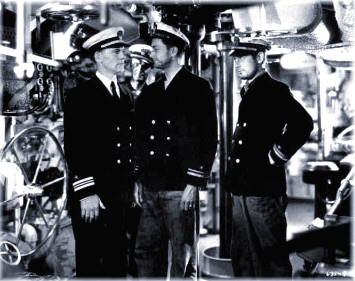
Principal Cast Members Down Below
Commander Edward Ellsberg's naval career reads like one of his adventure novels. The son of Russian refugees from Czarist Russia, he was born in New Haven, Connecticut and raised on the frontier in Colorado. He was one of the few Jews to be accepted into the U.S. Naval Academy in 1910. He graduated first in his class in 1914 at Annapolis, having made the midshipman cruise in the summer of 1911 to Europe aboard the USS Indiana. He was proud of being the first Jewish midshipman to graduate at the top of his Naval Academy class. After he served on the battleship Texas (BB-35) for a year, the Navy sent him to Massachusetts Institute of Technology for postgraduate training in naval architecture. He spent World War One at the Brooklyn Navy Yard where he was in charge of converting seized German liners into troop transports. He worked on the repairs to the cruiser Huntington (CA-5). He achieved the temporary rank of lieutenant commander in the Construction Corps and was construction superintendent for the battleship Tennessee (BB-43). Then, he returned to MIT where he earned a master's degree in 1920. Ellsberg made a major career choice in becoming a naval constructor. Staying in the line officer corps would have been a safer career move.
His first assignment was to the Boston Navy Yard as a planning officer in the Hull and Engineering Departments, where he designed an effective and innovative method for launching large ships. In the New York Navy Yard in 1924 he solved the ventilation and boiler problems vexing the former German liner Vaterland, now the Leviathan, the flagship of the U.S. Merchant Marine. Then, in September 1925, the submarine S-51 sank after being struck by the City of Rome. The Navy decided to raise the sub, and Ellsberg volunteered for the job. The salvage team was headed by then Captain Ernest J King, later Commander in Chief, United States Fleet and Chief of Naval Operations during World War Two. Ellsberg served as salvage officer for the ten months it took to raise the S-51. At age thirty-four Ellsberg became the first naval officer to qualify as a deep-sea diver. Ellsberg's reputation as an expert in submarine salvage was established and he received the first peacetime Distinguished Service Medal. The S-51 salvage operation was the start of an important life-long friendship between Ellsberg and King.
The salvaging of the S-51 garnered a lot of press coverage and Ellsberg began writing and speaking about his experiences. However, according to the navy ethics of the time an officer was not suppose to use his experience to lecture or write for profit. Then a change in the law regarding navy promotions meant a deserving officer like Ellsberg would have to wait years for promotion. Ellsberg resigned in 1926 and went to work for the Tide Water Oil Company as the chief engineer. But he remained in the Naval Reserve. He returned to active duty in December 1927 to assist with the salvage of submarine S-4 which had sunk off Cape Cod. An act of Congress promoted him to commander in the Naval Reserve over the objections of the Navy.
When the submarine Squalus (SS-192) sunk in 1939, Ellsberg was serving as a Naval Reservist aboard the aircraft carrier Ranger (CV-4). He was flown to Portsmouth, New Hampshire and watched as the survivors were brought to the surface using equipment he had been instrumental in developing.
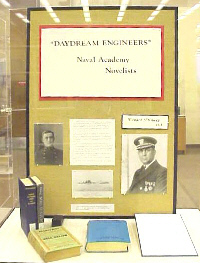
Literary Tribute to Ellsberg
at Annapolis |
In the late 1920s Ellsberg began along career as a writer of naval history and naval fiction. Over the years he published seventeen books. His adventure stories were published in the pulp magazines. His books and stories inspired many young men to enter the Navy and to become divers. His 1929 On The Bottom about the salvage of the S-51 became a best-seller. Pigboats came out in 1931. By 1935 Ellsberg had left Tide Water to concentrate on writing. On December 8, 1941 he was back in the Navy as a lieutenant commander. Admiral Nimitz said" If the Navy ever needed a salvage officer, they need one now!"
In March 1942 Ellsberg found himself in Massawa, Ethiopia (now Eritrea). Rommel was nearing Alexandria. Efficient delivery of war supplies was critical. His mission was to clear the port and return the dry docks and associated repair facilities to working condition. The defeated Italians had sabotaged and destroyed the port facilities and sunk ships to block the port. Under the most appalling conditions without the necessary equipment, and without experienced personnel, Ellsberg succeeded in restoring Massawa as an important regional repair facility. He raised the sunken dry dock in nine days and was promoted to captain. In eight months he re-floated four cargo ships, another dry dock, and a floating crane. He refurbished more than eightyy supply ships and actually repaired three British cruisers in an undersized dry dock by lifting one end at a time! He received the Legion of Merit for this accomplishment. Without a break Ellsberg was dispatched to French North Africa in November 1942 where in the wake of Operation Torch he continued his work by clearing the harbors of Oran, Casablanca, and Algiers and salvaging torpedoed ships. He received a second Legion of Merit but the strain was too much. Eventually he was named a commander in the Order of the British Empire for his work. He was sent back to the States in 1943 for recuperation and eventual ship-building responsibilities in New York.
In the spring of 1944 he was in Europe involved in the Normandy Invasion advising on the massive Phoenix concrete caissons for the artificial Mulberry harbors and was ashore by D-Day+6 but was eventually sent back to London and then to the States by September 1944. After serving in Cleveland supervising small craft ship building and still not well, he was finally released from active duty in March 1945.
Ellsberg continued to write after the war and consulted for ship-building companies. He passed away in 1983 at the age of ninety-one with the rank of rear admiral. At the age of fifty-one he was still diving on wrecked ships, personally placing pumps and explosives. His philosophy was "It never pays to quit until you're dead."
Andrew Melomet, Proprietor of Andy's Nickelodeon, will answer your Great War film or video inquiry. He is also soliciting your recommendations for the WWI Filmography he is compiling for our readers. Just click HERE.
|
|
| The following are thanked for their contributions to this issue of the Trip-Wire: Tom Jones, David Homsher, Susan Neeson, the Family Gallagher, Fred Castier, Tony Langley, Sidney Clark, Christina Holstein, Tony Noyes, Andy Melomet, Kimball Worcester, and Len Shurtleff. The World War I Document Archive helped with both our Literary and 90th Anniversary features. The William Seegers article was found at Wikipedia. Until next month, your editor, Mike Hanlon. |
SUBSCRIBE TO THE TRIP-WIRE
(Or send it to a friend)
(Or send us a comment on the TRIP-WIRE)
CLICK HERE TO CONTACT US VIA EMAIL |
For further information on the events of 1914-1918
and membership information visit the Directory Pages of:
|
| |

